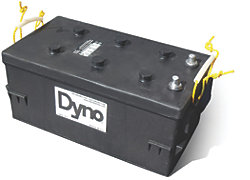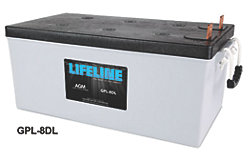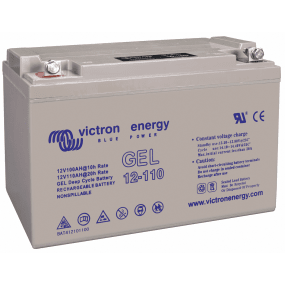Choosing the Right Marine Battery
Flooded Batteries
Also referred to as “wet cell”, flooded batteries use a reservoir of liquid sulfuric acid between their lead plates that produces hydrogen and oxygen when the battery is being charged. Because of the hydrogen, the batteries must be vented to allow the gas to escape safely. Without this, they would overheat and boil over – so you must ensure these batteries have adequate space for ventilation. Flooded batteries also need distilled water added regularly – so make sure you have a way to access them easily.
Usually cheaper than all other battery types
Can last longer if well maintained
98% recyclable
Easy to find and purchase all over the world
Handle overcharging better than most other batteries
Must remain upright or the acid can spill out
Need good ventilation
More maintenance with the need to occasionally top up with distilled water
Cannot be installed near sensitive electronics
Self-discharge rate is higher (6-7% per month) than other batteries
AGM
Absorbent Glass Mat (AGM) batteries are sealed, so they don't have the same ventilation requirements as flooded batteries. While technically a type of wet cell, in absorbed glass mat batteries, the positive and negative plates are separated by an absorbent fiberglass mat that holds the acid electrolyte like a sponge. This minimizes the potential for electrolyte spillage. During the charging process, these batteries have pressure valves that allow the oxygen from the positive plates to move to the negative plate, where they recombine with hydrogen, producing the water that the battery needs – so there is no need to top up! While these are a sealed battery, they do have a pressure relief valve that can release excess pressure if needed – and so require adequate ventilation. AGM batteries are deep-cycle batteries. Deep-cycle batteries, like the Optima Blue, are batteries that can be discharged and recharged repeatedly without losing their capacity or performance. AGM marine battery technology is improving, so it pays to do some research to make sure you are getting the best bang for your buck!
Maintenance free
Greater charge currents – so can use as a starter if needed
Greater charge acceptance (up to 40% of capacity) so quicker recharge
Only a 3% discharge rate
Resistant to vibration
Spill-proof, leak-proof and submersible
Require a “smart” charger
Sensitive to overcharging (keep under 14.4 volts)
Shorter life cycle in deep cycle applications than Gel or Flooded
Overcharging greatly reduces battery life
Cost less than LiFePo4, but more expensive than Flooded
Gel Batteries
Gel batteries are popular in marine applications due to their unique properties. Unlike traditional lead-acid batteries, they utilize a thickening agent to create a gel-like substance, offering significant advantages for marine use. One key benefit is their exceptional cycle life, providing up to three to four times the lifespan of standard AGM or flooded batteries, making them a cost-effective choice. Additionally, gel batteries boast a higher depth of discharge, allowing you to utilize up to 100% of their capacity without damage, ensuring extended usage without worrying about power depletion.
Their resistance to vibration and shock makes them ideal for marine environments with constant movement, ensuring durability even in rough waters. Gel batteries also function well in a wide range of temperatures, from hot tropical climates to freezing regions, maintaining consistent performance. Moreover, they recharge faster than AGM and flooded batteries, offering quick turnaround times for marine enthusiasts needing rapid power replenishment between adventures. These features collectively make gel batteries a reliable and efficient choice for marine enthusiasts seeking high-performance power solutions.
Sealed, no-maintenance design
Longer cycle life than flooded batteries
Better tolerance for deep discharges
No need to add water or check electrolyte levels due to the sealed design
Spill-proof, mountable in any position
Low 3% monthly discharge rate
Higher cost compared to flooded or AGM batteries
Susceptible to damage from high temperatures
Not ideal for engine starting purposes
Slower recharge rate compared to other battery types.
LiFePO4 (Lithium Iron Phosphate)
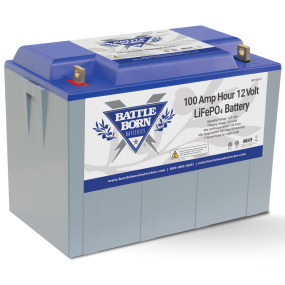
So what's the downside? These batteries are more expensive (but when you compare pricing, remember that you can use 100% of the stated Ah capacity of a LiFePO4 battery vs. only 50% of a lead or traditional AGM) and are particularly sensitive to charge requirements
Up to 70% lighter
Higher depth of discharge (up to 100% vs. 50%)
Higher life cycles (up to 3X) = longer life
Up to 70% smaller footprint
Faster recharge
Consistent voltage during high loads
Lower self-discharge than other battery types
Operates within wider temperature ranges (–20°C to 60°C)
Isn't damaged by extended time at high discharge
Expensive
Need integrated BMS
May need to upgrade onboard Charger
Need to change charge profile below freezing (0°C or 32°F)
Not suited as a start or bow/stern thruster battery
Not for the DIYer
A Few More Important Things to Remember…
When buying a new set of batteries, it's imperative that you not only purchase the same type of batteries (Flooded, Gel, AGM, or LiFePO4), but that they are made by the same company and manufactured around the same date. It's never a good idea to combine batteries that have different “birthdays”. If you do – the older battery will often negatively affect the performance of the newer batteries.
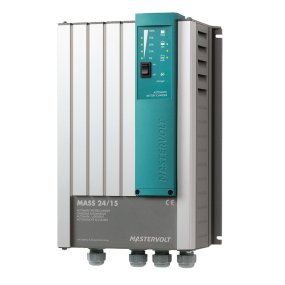
One more important thing to remember – when choosing the best battery for your boat, you must make sure that your charger is set up with the correct charge profile for the battery type you have selected – or you may be buying new batteries a lot sooner than you expected! Today's “smart” battery chargers can usually handle any type of battery if you choose the correct settings. In addition, newer chargers monitor battery charge state to provide the optimum charge process – providing for the fastest recovery and ideal conditioning – which can lead to a longer life span for your batteries. If you haven't bought a new charger in a while and you are planning to invest in new batteries – now is the time to upgrade! Fisheries Supply carries a multitude of batteries and accessories.
What features should you look for when choosing the best marine battery?
When choosing the best marine battery, look for features such as deep cycle capabilities, high reserve capacity, maintenance-free design, and durability. Additionally, consider the battery's size and weight to ensure it fits your boat's specifications and is easy to handle.
What is the best amp hour for a marine battery?
In order to start the engine, a starter battery should be able to deliver 75 to 400 amp for a short period, between 5 and 15 seconds, but it does not need to have a high storage capacity. On the other hand, a marine "house" battery only requires approximately 80 amps but should have the ability to run for extended periods of time.
Finally, if you aren't 100% sure about how to set up your electrical system, we highly recommend that you hire an experienced installer.
We hope this Navigator has been helpful. If you have any additional questions about batteries for boats, best marine cranking battery or need clarification, check out the other battery topic links below, or feel free to contact our battery experts at (800) 426-6930.
